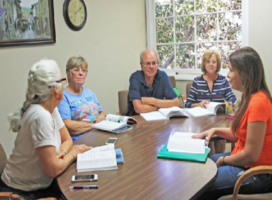Spanish Language Schools in the United States
More than 400 million people speak Spanish globally, making it the world's second most spoken language and a bridge between many people and cultures. From Buenos Aires to Barcelona, Caracas to Quito, Havana to San Juan, Spanish is the native language in 20 countries (including Equatorial Guinea in Africa), and spoken as a second language in many more, like the United States.
Whether you're from outside the United States and want to experience its diverse and varied culture, or you're an American hoping to travel outside of your hometown and get to know your Spanish-speaking neighbors, there are endless opportunities to learn Spanish in the United States.
As a language student, you can choose to settle into the colorful Mission District of San Francisco, enjoy the flavors of Tex-Mex in El Paso or Austin, or explore vibrant Little Havana in Miami, just to name a few of the many Spanish-speaking communities across the United States.
Course Types
Spanish courses can be found at nearly every university in the United States, making university courses a great option for those wishing to combine learning Spanish with studying abroad in the United States. You'll likely need to follow a standard application processes for university study -- which can be a lot of effort if you only want to enroll in a single language course -- so you may prefer to combine Spanish courses with an undergraduate or graduate study abroad program in the United States to get the most bang for your buck. Many universities will also have foreign language clubs or conversational classes where you can practice your Spanish skills with other students outside of the classroom.
If you're not looking to spend a semester in the classroom and want a shorter alternative to university studies, Spanish language schools are a great option. They typically offer more intensive courses over a shorter period and give you the freedom to choose when you want to study, for how long, and the number of hours per week. Dedicated Spanish language programs are more likely to be found in larger cities and places with more significant Spanish-speaking populations. Many language programs allow you to live with a Spanish-speaking host family, as well.
Finding a private Spanish tutor should be a breeze given the number of native Spanish speakers in the United States. If you do best with lots of personalized instruction or have a very specific Spanish language goal in mind, the less structured nature of one-on-one lessons might be the best fit!
Why Learn Spanish Abroad?
With over 400 million native speakers worldwide, Spanish is the second most widely spoken language in the world, and the official language of 20 countries spread across South, Central, and North America, as well as parts of Africa and Europe.
Hispanics are the largest minority in the United States and Spanish is the second most spoken language. It's predicted that the United States will surpass Mexico by 2050 and become the largest Spanish-speaking population in the world!
The sheer number of Spanish speakers globally make it a great choice for those wanting to learn another language. Learning Spanish can help you connect with your neighbors, open doors to professional and educational opportunities around the world, and make travel to Spanish-speaking countries easier!
Qualifications
Spanish language courses are available for learners of every level -- whether you're just starting out, or are a more experienced Spanish speaker -- and requirements vary greatly depending on the provider you choose.
In most cases, no prior Spanish language experience is required, though language schools may request that you take an assessment to gauge your level of experience and ensure you enroll in the course that's best suited to your skills.
Generally, university and study abroad programs will have more strict requirements and require you to go through the normal university application process. This will likely involve filling out an application and making sure you meet the general academic requirements of the university. Even though your aim is to learn Spanish, almost all courses at universities will be taught in English, so you may need to prove your English language skills through a proficiency test.
Popular Locations to Learn Spanish in the United States
Spanish language courses can be found in virtually every city in the United States, though more than half of the United States' Hispanic population can be found in just three states: California, Texas, and Florida.
In Miami, nicknamed "the Capital of Latin America," Spanish is spoken almost everywhere and you'll find Cuban, Haitian, and other Latin American influences through the city. Enjoy sunshine year-round on its white, sandy beaches, snack on Spanish tapas and crispy empanadas, and sip on Cuban coffee in this cultural melting pot.
Nearly half of Los Angeles residents can trace their roots to Latin American origins, and large Spanish-speaking populations can be found along the California-Mexico border in cities like San Diego. With vibrant Hispanic art, culture, and communities, California is a hub for Spanish speakers in the United States and a great place for language immersion.
Sharing a border with Mexico, you'll find Texas is heavily influenced by its neighbors to the south, particularly in El Paso, Houston, San Antonio, Austin, and Dallas. From the flavors of Tex-Mex to Latin American music and art, and the celebration of holidays like Cinco de Mayo and Dia de Los Muertos, the Hispanic population in Texas has long shaped its culture.
Choosing a Language Learning Program in the United States
Once you've done the hard work of choosing which language you'd like to learn and the country you want to study in, it's time to take the next step in choosing the best course for you.
University programs can be drastically different than dedicated language programs and private tutoring, so it's important to consider what is most important to you as a student -- whether that's college credit, individualized instruction, affordability, or cultural immersion. Here are some things to consider before choosing a Spanish language course:
- Affordability: Being stressed about finances and covering your expenses while abroad will take away from your international experience and ability to learn. It's important to create and stay within a budget during your time abroad.
- Program Support: Studying and living in another country can be intimidating. If it's your first time abroad, you may want to look into programs that offer in-country support and assistance.
- Topics Covered: Are you interested in history, culture, and the arts? Do you want to travel and engage with the locals? Is your goal to work or study abroad in a Spanish-speaking country? Consider whether you're more interested in learning conversational Spanish, growing your vocabulary in a certain area, or becoming as fluent as possible.
- Class Time: Decide how many hours of instruction per week you're willing to commit to, and how they fit into your schedule. Keep in mind that you're likely to be studying outside of the classroom, and will also want to spend time getting to know the city you're living in.
- Class Size: The number of students per class is more important thank you think. Classes can be quite large at major universities, and depending on your learning style, you may be better suited to smaller groups or one-on-one tutoring. That being said, larger class sizes do have their benefits. They may make it easier to make friends, form study groups, and learn from your classmates.
- Cultural Immersion: If you want to live in a Spanish-speaking community, or with a Spanish-speaking host family, this may massively influence where you choose to study.
Cultural Immersion in the United States
With a population of more than 325 million, the United States is the third largest country in the world and has long been considered a cultural melting pot. Due to the diverse background of the people who have settled there, there's really no such thing as a "typical" American. Beliefs, value, and traditions vary widely across the country, and you're likely to encounter many sub-cultures within each region, city, and even neighborhood in the United States.
Average Spanish Language School Tuition in the United States
Program costs for learning Spanish in the United States vary from fairly inexpensive to quite costly depending on the length of your course, its level of instruction, and whether you choose to study at a university or language school in a large city or smaller town.
University tuition in the United States can range from a few thousand dollars to tens of thousands per semester and is often more expensive for international students. Private universities are the most expensive, followed by public universities and colleges, with two-year colleges (known as community or technical colleges) being the most affordable.
Short term-programs are typically less expensive overall than semester or year-long study abroad programs at universities, particularly when you factor in living costs. Intensive language programs start from just a few hundred dollars.
Scholarships for Learning Spanish in the United States
Studying abroad or taking a language course in the United States can be costly, but it doesn't need to break the bank.
If you plan to study at a university, make sure to take advantage of the resources available to you. Speak to a financial aid advisor about university specific funding options and any scholarships you may be eligible for.
There are plenty of scholarships and grants to assist you with your studies and help make ends meet, and many funding opportunities geared specifically toward language-learning and studying in the United States.
- The Fulbright Foreign Student Program provides funding to approximately 4,000 foreign students each year, including those who wish to study and conduct research in the United States.
- The Hubert Humphrey Fellowship Program allows students to undertake 10 months of non-degree academic study in the United States.
- Abbey Road Summer Scholarships offer language and art students in the United States $1,000 scholarships.
- Tortuga Backpacks Study Abroad Scholarship award international students wishing to study in the United States $1,000 scholarships.
- CIEE's Language Intensive Focus Track (LIFT) scholarship program provides funding for students pursuing intensive language study through a year-long CIEE program.
Cost of Living in the United States
Living costs in the United States vary greatly from region to region. Major cities like New York and San Francisco are among the most expensive in the world, while smaller towns and lesser populated cities can be quite affordable.
Many students in the United States live on-campus in dormitories or in rented homes or apartments shared with other students to cut down on living costs. Rent can range from a few hundred dollars per month in a shared house in a mid-sized university town, to several thousand dollars for a single bedroom apartment in major cities.
A monthly public transportation pass will typically cost between $70-$120. If you're studying in a more rural area or smaller city, finding housing near your language school is important, as not all places will have great public transportation.
Food costs will be different depending on what you eat and where you're living, though as a general rule of thumb, cooking at home will be cheaper and healthier than eating out. The average meal out costs around $13, you can find a beer for around $5, and a cocktail or glass of wine for around $11. Tipping is not mandatory in the United States, though it's standard to tip 15-20% of your bill.
Keep in mind that most states have sales tax (an average of 7.25%) and it's not included in the price of any items. Instead, it will be added to your bill when you go to pay.
Visas & Other Relevant Information
There are several visa types that allow visitors to study in the United States. It's best to ask your program provider which type of visa you require to participate in their program, and double check with the United States Embassy or Consulate in your home country to confirm.
The United States has a Visa Waiver Program (VWP) allowing citizens of participating countries to stay in the United States for up to 90 days for business or tourism purposes. If you plan to undertake recreational study (non-credit) as part of your visit, you may be able to complete your Spanish language course in the United States under the VWP.
In order to travel to the United States on the VWP you must first apply online for authorization through the Electronic System for Travel Authorization (ESTA). The application fee is $14, and in most cases, you'll receive immediate approval, though it is recommended to apply as early as possible.
If you will be receiving university credit for the Spanish language course you take, you will need to apply for an F-1 student visa. Only schools certified by the Student and Exchange Visitor Program (SEVP) can accept international students. Once you've applied for and been accepted to a SEVP-certified school, you will receive a Form-120 and will need to pay the SEVIS I-901 fee ($200). Next, you can apply for your student visa.
To apply for a student visa, you'll need to complete an Online Nonimmigrant Visa Application (Form DS-160), upload a photo, and schedule an interview at the United States Embassy or Consulate in your home country. Depending on the city you live in, wait times for interview appointments vary from a few days to several weeks.
You may be required to pay an application fee of $160 prior to your interview, and once your visa is approved, you could be subject to additional visa issuance fees depending on your nationality. New F student visas are issued up to 120 days before a course start date, but you will not be able to enter the United States on your student visa more than 30 days before your course starts. You must depart the United States no more than 60 days after your program end date (listed on your Form I-20).













